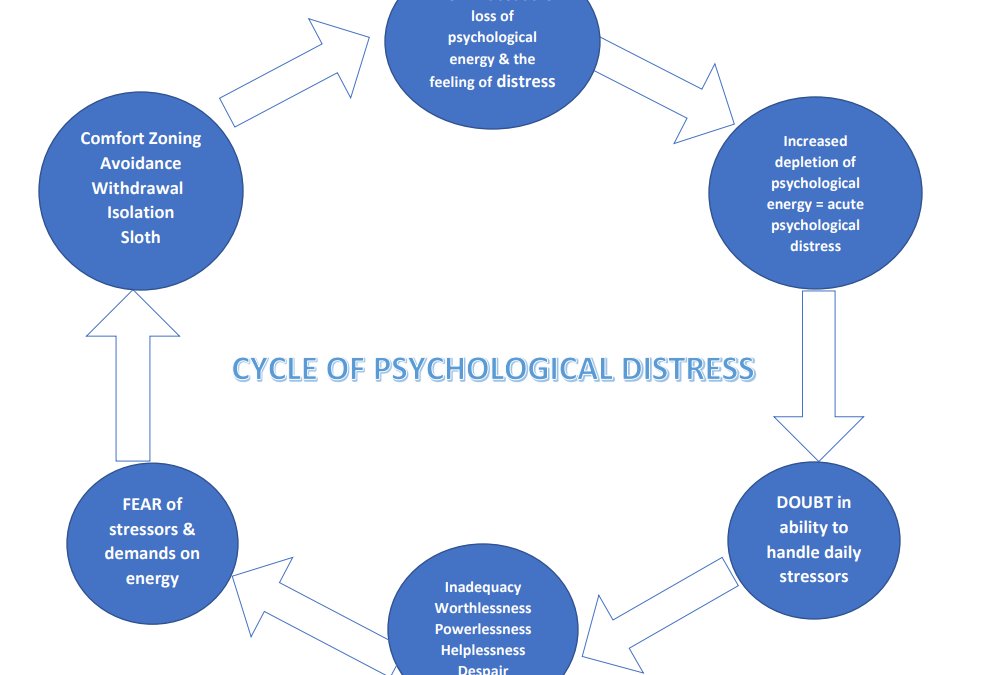When the depletion of psychological energy is prolonged, the human mind has a sense or a warning system that the energy in the psyche has been reduced to a level that is considered critical. Critical means that the amount of psychological energy currently available to the individual is insufficient to meet the demands of the day. When this awareness leads to the realization that the individual is not able to handle the normal stressor weights and measures to which the individual is accustomed anxiety levels accelerate. This acceleration occurs because the inability to manage daily stressors is read by the body to be a threat to the individual’s ability to maintain survival. This realization may then cause the individual to react in ways that maybe maladaptive exacerbating current distress levels leading to debilitative distress cycling.
This leads the individual to cope by engaging in worry. As the worry about the loss of psychological energy increases the levels of remaining psychological energy rapidly deplete. This worry reaction moves the individual rapidly towards a state of acute psychological distress. This heightened distress produces more worry resulting in spikes in the anxiety that lead to panic attacks.
The onset of the spiking anxiety and panic attacks produce an overwhelming sense of doubt within the individual surrounding one’s capability to complete tasks that at one time seemed simple. This doubt is accompanied by an intense sense of failure and inadequacy that leads to a belief that the individual is powerless and helpless to regain past levels of competency and functioning. This crushing sense of self defeat and worthlessness then leads to persistent and inescapable feelings of despair.
This despair generates a concentrated fear of stressors or demands for energy that might come at the individual from the external universe. This fear of stressors ranges from a fear of the smallest request all the way up to the Herculean demands from the workplace that seemed overwhelming even when the individual was at an optimal functioning level. This fear leads the individual into a complete shutdown meaning that the mind and body literally refuse to function or give any energy or effort towards task completion. At this point the individual focuses on avoiding the external universe at all costs by withdrawing and isolating. They seek refuge in a zone that brings some guarantee of total separation from energy demands. This refuge is called a comfort zone. This zone specifically serves the individual very much like a surrogate womb which literally surrounds, protects, and supports the weight of the individual. Once the individual has established that zone of comfort a dependence upon that womb-like refuge begins to form. The individual then burrows into that dependence regressing towards infantile states of powerlessness and helplessness. Should the individual remain in this regressed state of dependence on this comfort over prolonged periods of time a fear of, and an aversion to, any form of effort or tasking multiplies as the helplessness and dependence accelerate.

What do distressed individuals do while they are in the comfort zone?
Once individuals arrive at this comfort zoning stage, they have a strong tendency to stay. This means pursuing a retreat further into the comfort zone becomes the distressed individual’s primary focus, which is to say that the individual has resigned themselves to comfort zoning and has a significantly reduced interest or desire to return to the real world. Having reached this advanced stage of dependence on a comfort zone the individual must now work to justify life in the comfort zone. The individual then begins the work of justification tasking. The comfort zoning individual must first establish and re-establish the plight of helplessness in order to justify disability and dependence, which is to say, I can’t support myself so stop expecting me to deliver effort. Second the individual must establish and re-establish the individual position of dependence in order to justify the retreat into the comfort zone, which is to say I must seek refuge in my shelter because the world of effort threatens me with energy demands thus living life in my refuge is justifiable. Third, the individual must establish and re-establish the total absence of independence in order to justify that my dependence on dependence is okay because if any form of self-reliance is present in my refuge then I cannot justify remaining in this state of withdrawal indefinitely, which is to say, I now depend on being dependent because any sign of independence threatens my ability to stay in my comfort zone refuge. Thus, this specific pursuit of withdrawal into the comfort zone then leads the individual to generate a dependence upon the state of dependence. This means that the individual views the state of dependence as a necessary buffer that provides a protective barrier between oneself and the real world of stressors outside the refuge. This dependence may then become the sole focus of individuals who find themselves in this debilitated state.
Why would comfort zoning lead the distressed individual to sabotage treatment?
Considering how distressed individuals retreat into these deeper states of dependence, becoming engrossed in maintaining helplessness we can see how they might also sabotage their own mental health treatment. We might even be able to understand how sabotage may become a necessary skill set for the distressed individual who is trapped in this cycle of helplessness, withdrawal, and dependence. This means understanding the distressed individual’s view that treatment of any kind must be sabotaged and rendered ineffectual as they cannot afford to have any treatment intervention pull them towards stabilization. This is true because if treatment were to stabilize the condition the individual would no longer be able to support the position of helplessness and dependence. In this event the individual would be taking steps towards leaving their comfort zone which would be in direct opposition to the gravity and inertia of the current state of dependence.
What is the force within distressed individuals that enable them to live in a state of inertia?
The primary character employed by the individual to help them establish and maintain this position of helplessness withdrawal and dependence is Sloth. The Sloth state of consciousness is designed to make the world small, removing all manner of exertion while establishing and justifying prolonged periods of inactivity and sedentary distractions. Individuals who reach this progressive level of psychological distress are now actively learning how to establish, maintain. and prolong the state of helplessness. As this state of helplessness, withdrawal and dependence persist, so again does the worry about the loss of energy, the doubt surrounding adequacy, and the fear surrounding coping with the demands of life. As this cycle of worry-doubt-fear accelerates and progresses so does the vicious cycle of psychological distress.
What is the treatment for someone stuck in this cycle of psychological distress?
The treatment for individuals who are stuck in the worry-doubt-fear cycle of psychological distress is a 7- stage process. These stages include,
- Self-accountability surrounding one’s dependence quotient.
- Regulating the gratification of comfort, avoidance, and Sloth.
- Correcting thinking errors surrounding the fear of stressors.
- Correcting thinking errors surrounding doubts about personal adequacy resourcefulness, and self-esteem.
- Understanding the impact of psychological energy depletion on productivity.
- Understanding the science of psychological distress.
- Correcting thinking errors regarding the use of worry as a coping skill.
The goals of this treatment process for the cycle of psychological distress include,
- To separate dependence issues from mental health issues.
- To increase ability to regulate the gratification of stressor avoidance.
- To clarify the positive role of stressors on personal growth and development.
- To dispel the myth that depletion = inadequacy.
- To clarify the mechanics of psychological energy depletion.
- To clarify the mechanics of psychological distress.
- To increase knowledge of adaptive coping skills for psychological energy depletion.
This treatment process can be done in either an individual or group therapy format. The primary objective is to break the cycle and free the mind from this individual reaction to the event of psychological distress. It is important to note that the distress cycle is not about the distress experience itself but is much more so more about the individual’s reaction to the experience of psychological distress. Not all individual’s experiencing psychological distress to the point of panic attacks will react with worry-doubt-fear cycling. Some individuals may stop the cycle in the doubt stage and still others in the worry stage never progressing to the point of doubt-fear and dependence on comfort zoning. Treatment should then focus on the individual’s specific reaction to the event identifying which stage in which the individual might be currently located. Treatment plans would then be customized using only the above steps that would apply to the individual’s particular reaction. In the event that the individual did not react with any of the steps in the distress cycle then general education on the science of psychological distress may well be sufficient.
Larry Marshall is a Licensed Professional Counselor at Greenway Therapy . Learn more about him on his BIO page.





